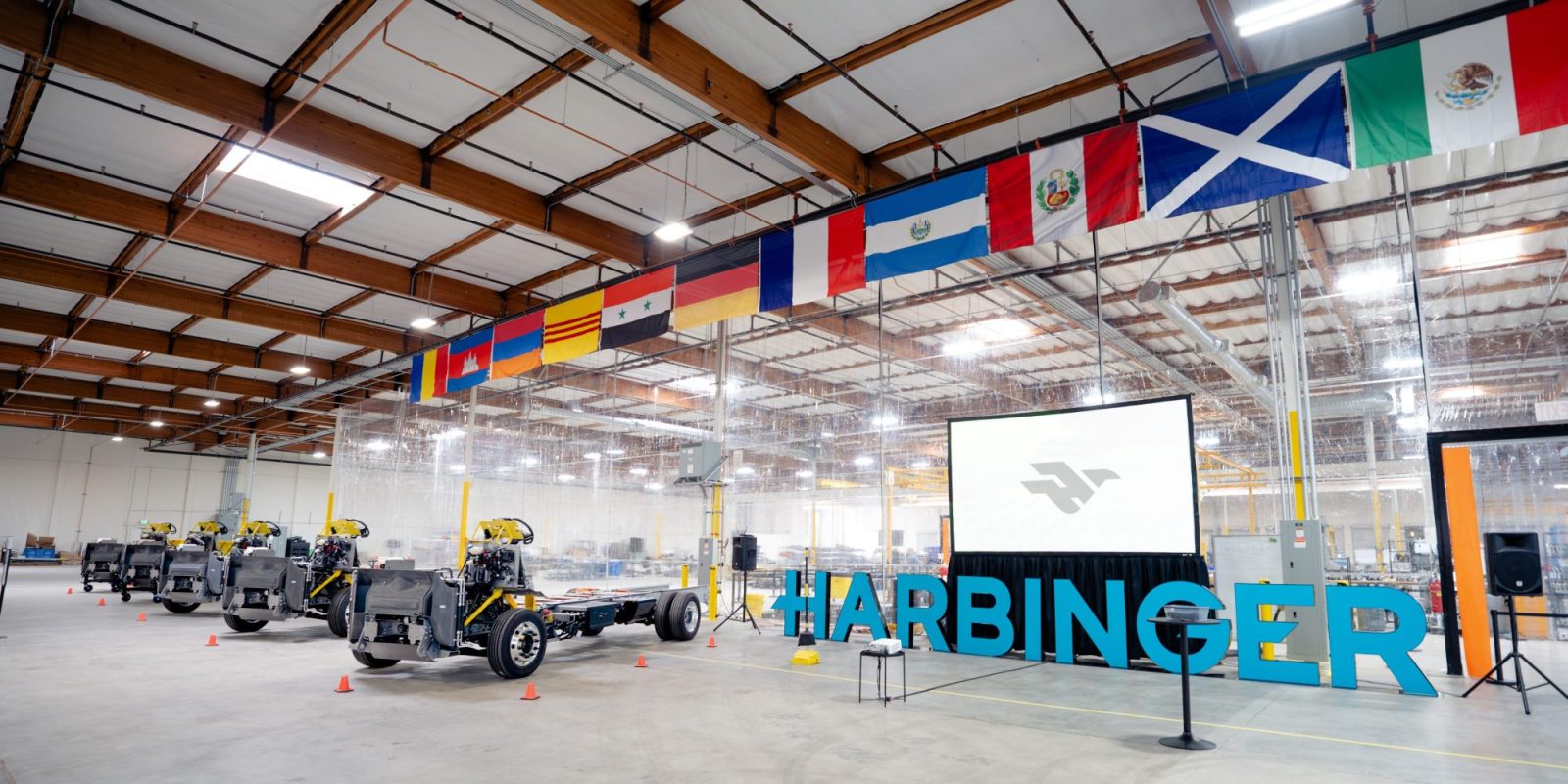
Harbinger Motors, a startup building medium-duty electric commercial vehicle chassis, has just opened its manufacturing facility in Garden Grove, CA, with an aim to deliver the first upfront cost-competitive medium duty EVs by the end of this year.
We headed over to Harbinger’s grand opening for its new facility to have a look at their technology and their big plans to shake up the medium duty market. It’s new Garden Grove facility is the first EV manufacturing plant in Orange County, CA – Rivian and Hyundai have headquarters here, but manufacturing is elsewhere.
The company is still quite new – it was only founded in 2021, and has a team of about 100 people total. But that team includes plenty of EV experience, with executives and engineers who formerly worked at Coda, Faraday Future, Canoo… and, of course, Tesla. Most notably, Harbinger’s Chief Production Officer is Gilbert Passin, who led Tesla’s production efforts in setting up its Fremont factory at the beginning of the Model S ramp.
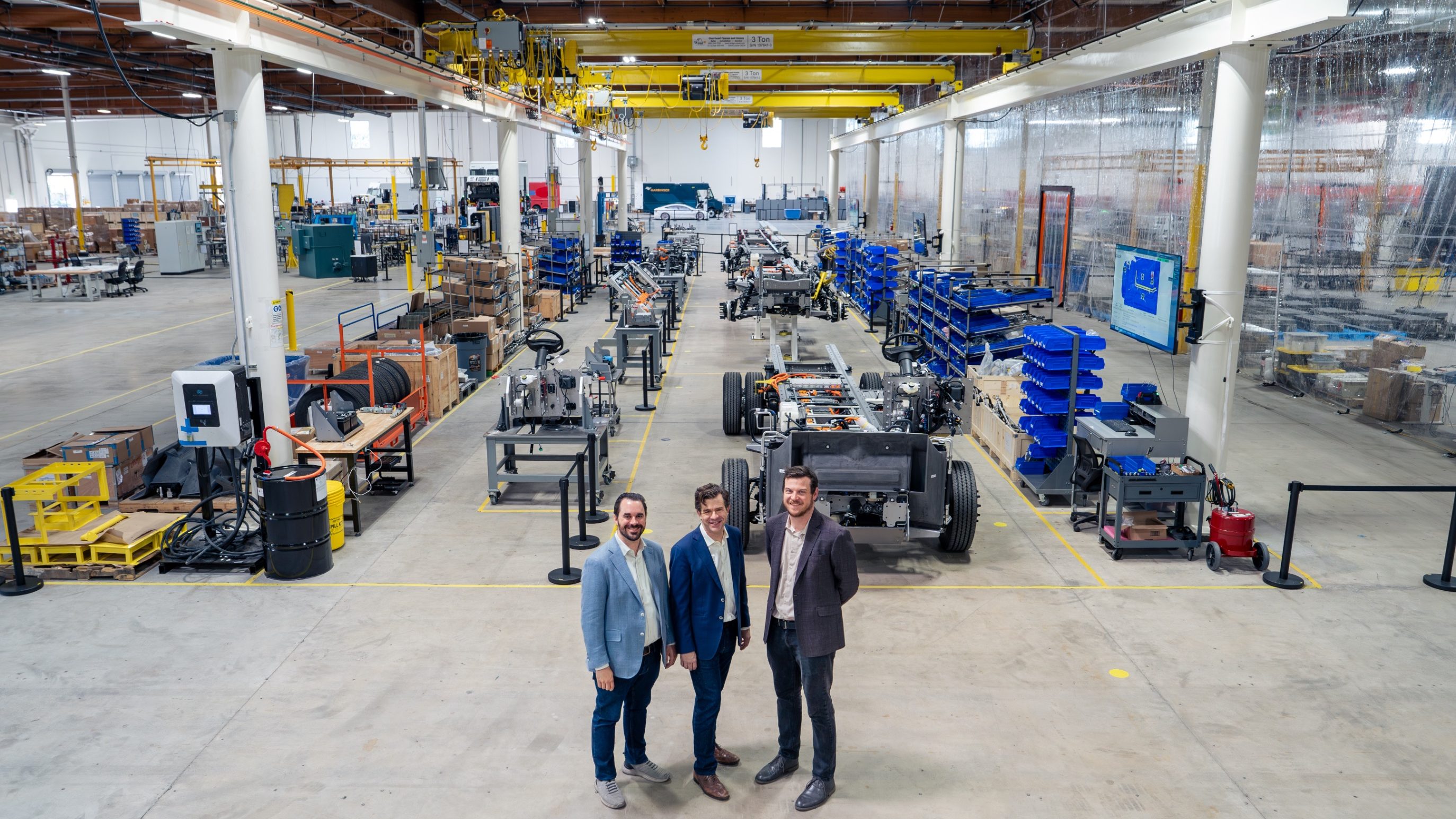
The goal is as you’d expect – to disrupt and electrify the medium-duty commercial market, specifically in the class 4-6 range of vehicles. These classes cover a large variety of vehicles, like walk-in vans, bucket trucks, beverage delivery, school buses and so on. And these vehicles do a lot of miles, use a lot of gas, and make a lot of pollution, often specifically in places where people live – so the potential gains for electrification are high (which is a big reason why California recently released big new truck regulations).
But Harbinger’s model is a little different from other entrants in the space. These types of vehicles can be sold as finished vehicles, as chassis-cab combinations, or as a stripped chassis. In the latter two cases, buyers will go to an upfitter to build their desired solution onto the vehicle chassis.

Harbinger is focusing on delivering stripped chassis, rather than finished vehicles or chassis-cab combinations. This allows for greater flexibility and simpler manufacturing for the company itself, and given that buyers are often going to need an upfitter anyway, there’s no sense in building up a whole vehicle when this way buyers can get exactly what they need.
To this end, Harbinger has recently delivered its very first customer chassis, to THOR Industries, an RV maker (and contributor to Harbinger’s Series A investment round). It was delivered to Thor’s Innovation Lab, to explore how electric chassis could be implemented into the company’s product design.
At its grand opening, Harbinger showed off several beta versions of its chassis, and its in-house designed motors and battery packs. The company uses a modular battery pack structure, with each pack holding 35kWh and chassis being configurable with 2-7 packs depending on application and length (wheelbase options go from 158″ to 208″). Packs are filled with standard 2170-sized cells from a top automotive cell provider (Harbinger wouldn’t tell us which one, but we did see some shipping labels on some crates in the battery area…).
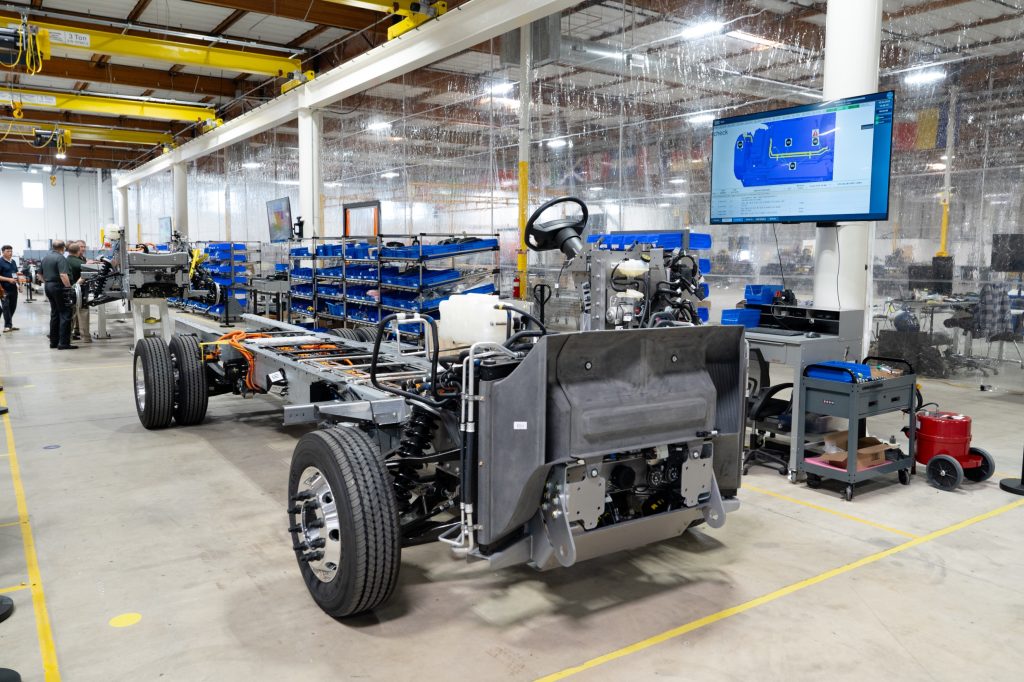
In-house design of components is an important distinguisher for Harbinger, which it says will help keep costs down. By building its own battery packs, its own driver-assist systems, using drive- and steer-by-wire – all of this means Harbinger says it will be able to offer lower prices than the competition.
In fact, it claims that not only will it start delivering the final product by the end of this year, but that it will deliver EV chassis with “zero price acquisition premium” over equivalent gas and diesel-powered chassis.
This is quite the claim – so far, we usually have a hard time even getting any price quoted from medium and heavy duty vehicle manufacturers. This is often because, well, they’re usually quite high in upfront cost compared to diesel vehicles. Due to lower long-term fueling and maintenance cost (Harbinger says its motors will last 450k miles) many businesses can save money long term with an EV, and economics are only getting better over time – but Harbinger isn’t promising lower longterm costs, it’s promising lower upfront cost as well.
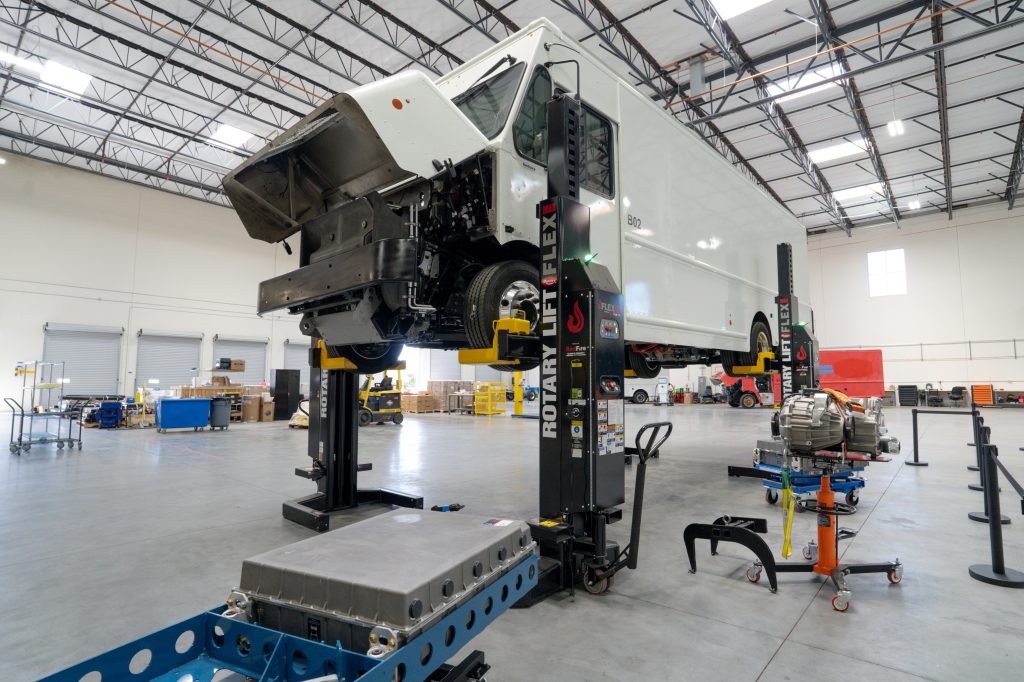
Now… part of this is due to recent incentives. The Inflation Reduction Act includes a $40,000 incentive for commercial vehicles, which certainly does a lot to bring the economics into balance for buyers (and note: diesel vehicles still benefit from the massive subsidy for ignored pollution costs). But even with all of that taken into account, Harbinger’s price-equivalence would be a first, and a first by a longshot, as far as we can tell.
Not only does Harbinger promise to be price-competitive with gas and diesel, it also says it will offer similar payload capacity. Harbinger told us that, in the 4-pack configuration, its vehicle is lighter than a Freightliner MT55 diesel chassis.
In the world of cargo hauling, payload is important – if you can carry more weight you can make more money, at least if you’re “scaling out” your capacity (as opposed to “cubing out,” filling up the vehicle’s volume with lighter goods). So losing out on payload to a bunch of batteries can be a no-go for some haulers, but Harbinger says you won’t have to make that decision.
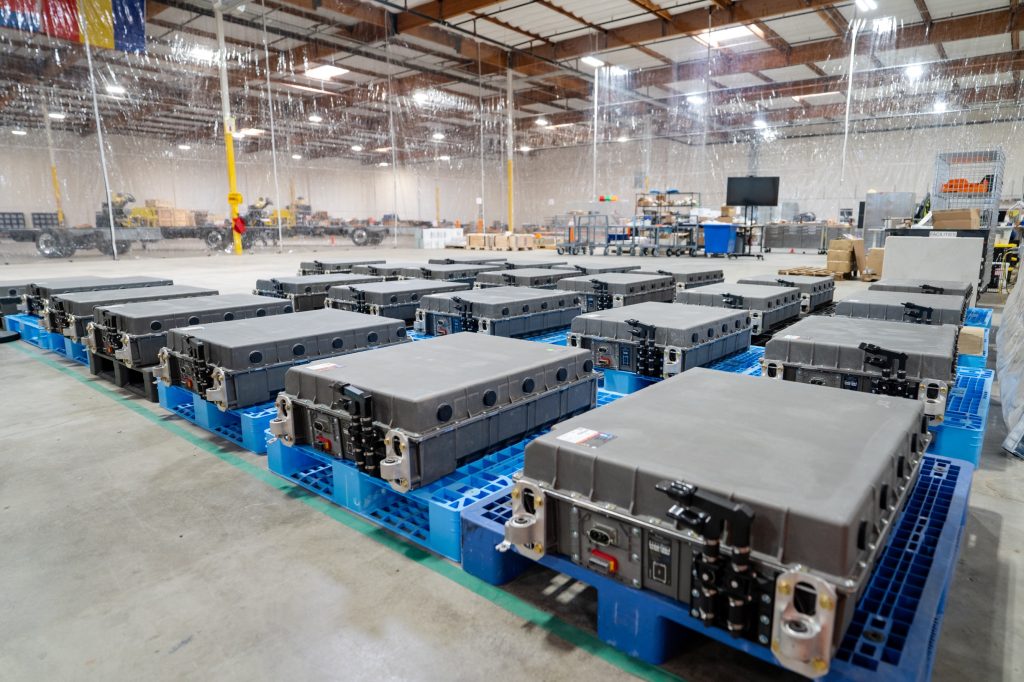
The 4-pack is estimated to offer somewhere around 165 miles of range on a 140kWh battery pack. This is more than enough for a lot of applications, but due to its modular design, Harbinger can offer configurations with less range (for campus or other low range vehicles, for example) or with over 200 miles of estimated range for the larger 5- or 6-pack options. Of course, range depends highly on use case, upfit solutions, how much you’re hauling, and many other factors.
Harbinger also wants to bring more driver assistance into the medium duty space. It’s not making any promises about automated driving (we couldn’t get them to say anything more than level 2, which is what nearly all consumer-available systems operate at these days), but it does want to add electronic aids to monitor driver attention and the surroundings of the vehicles, both to avoid accidents and potential loss of goods. It’s designing its own systems for this, detecting and tagging objects, and selling ADAS kits along with its vehicles that it will instruct upfitters how to install and calibrate.
All that in-house design means it won’t have to purchase solutions and pay extra margins to other providers – but it also means a lot of work for a small company, especially one that wants to start delivering by the end of this year.
Electrek’s Take
This isn’t the first we’ve met the Harbinger team, as we saw them last year at ACT Expo and had a quick drive around the parking lot in an early demonstration vehicle. And this drive was fine, the truck worked, it had been running for hours with lots of drivers, and felt about as we expect an electric medium duty vehicle to feel (that is, better than the diesel version – more nimble, more quiet, more clean).
But at the time and now, we were skeptical of Harbinger’s big claims. It’s not that we have any particular reason not to believe them, except that the claim of price parity from a startup when nobody else has even gotten close are extraordinary. And extraordinary claims require extraordinary evidence, so we have to wait and see. If they can follow through on them, it will be a revelation.
And there is plenty of talent within the ranks with EV industry experience. Some of it comes from famous failures like Coda and companies that have never quite got off the ground like Faraday Future, which we can optimistically hope has helped provide warnings about overpromising. And what Harbinger is promising isn’t that crazy, it’s just a commercial van – but the price still seems hard to deliver.
But the presence of Gilbert Passin as Chief Production Officer, who led the early stages of bringing Tesla into the volume manufacturing business with the Model S, certainly lends a lot of credence. Passin most recently headed up Wrightspeed, Tesla co-founder Ian Wright’s attempt to electrify garbage trucks, and has previously worked at several large traditional automakers as well.
So we remain quite interested in what Harbinger has to do, and if they deliver on these promises, it will be a Really Big Deal™. We just wouldn’t be surprised to see them slip a little… but even if they do slip, the product could still be a solid offering anyway.
One last thing to note – at the event, Harbinger parked 5 food trucks inside the huge factory building. This was neat and provided a lot of food options, but between the vehicle exhaust driving in and out, and the smoke coming out of the BBQ truck, my eyes and nose were starting to hurt by the end of the event, to the point where I sheltered myself in the battery area of the factory (which has its own separate climate control) for respite.
Wouldn’t it be nice if those medium-duty commercial trucks had an option to avoid exhaust in similar situations? I wonder where we might find an option like that…
FTC: We use income earning auto affiliate links. More.



Comments